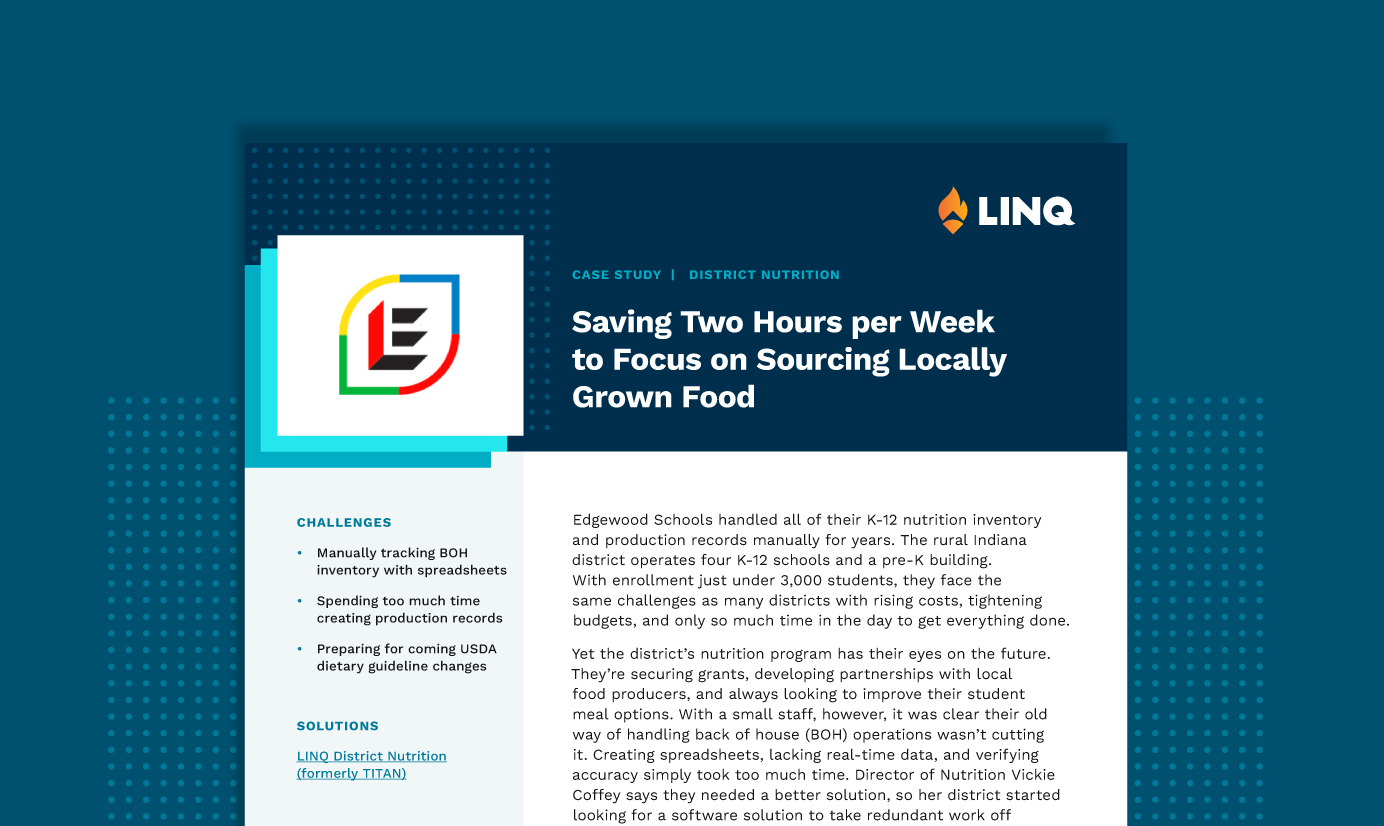Skip to Section:

“It saves us at least two hours per week, and the three-week average really helps with our purchasing decisions.”
Vickie Coffey
Director of Nutrition
Edgewood Schools, IN
Edgewood Schools handled all of their K-12 nutrition inventory and production records manually for years. The rural Indiana district operates four K-12 schools and a pre-K building. With enrollment just under 3,000 students, they face the same challenges as many districts with rising costs, tightening budgets, and only so much time in the day to get everything done.
Yet the district’s nutrition program has their eyes on the future. They’re securing grants, developing partnerships with local food producers, and always looking to improve their student meal options. With a small staff, however, it was clear their old way of handling back of house (BOH) operations wasn’t cutting it. Creating spreadsheets, lacking real-time data, and verifying accuracy simply took too much time. Director of Nutrition Vickie Coffey says they needed a better solution, so her district started looking for a software solution to take redundant work off their plates.
Edgewood Schools needed a BOH K-12 nutrition management solution
Coffey says the need for a BOH solution led them to LINQ Nutrition. They were already using free software, like Google Sheets, to wrangle inventory and production records, but it became unwieldy. “We were updating the spreadsheets manually, so we knew we needed a solution built for K-12 nutrition inventory,” Coffey remembers. Without automation and real-time data, Edgewood Schools relied on updating spreadsheets manually to ensure their inventory and production records were accurate. Additionally, completing production records and verifying their accuracy took too much time.
Tedious BOH management also made it harder for Coffey and her team to prepare for upcoming changes to the USDA nutrition standards. Because their spreadsheets weren’t part of a software solution built specifically for K-12 nutrition, they weren’t designed to track ingredients and nutrition profiles. Although the district already implemented a 100% whole grains practice, it was easier to manage because it meant simply avoiding entire items like white bread and white pasta. Adhering to smaller changes, like proposed reductions in salt and sugar standards, would be too complex to tackle manually.
Finding a solution that saves two hours per week and delivers real-time data
Coffey’s district found the solution in LINQ Nutrition. “It gave us the functionality we needed,” she explains. It simplified inventory and production records and was built specifically for the complexities of K-12 nutrition. That meant it could adapt to the unique needs of their program, like adhering to USDA nutrition standards and sourcing foods from U.S. suppliers.
In addition to solving their immediate need for a faster, easier way to handle inventory and production records, LINQ Nutrition also offered features to improve their program across the board.
“Hands-down, the inventory-at-a-glance is my favorite feature,” Coffey says. “We do a lot of transfers between schools, so I need to know what’s at each location. Now, I can make those decisions right from my desk.” Because they’re a smaller district with kitchens located close to one another, transferring items helps them run their program more efficiently. In the past, it was much harder to verify what exactly was in each freezer and pantry. Now, Coffey knows in an instant where everything is.
She also says the system automates their production records, ensuring accuracy and saving them a lot of time. “It saves us at least two hours per week,” says Coffey, “and the three-week average really helps with our purchasing decisions.” With accurate, real-time inventory and production record data, the district can make smarter purchasing decisions to maximize their resources. “We’re definitely more efficient,” Coffey explains, “and we’re saving money as well, which helps because we’re always looking at tighter budgets.” Higher grocery and supply costs continue to challenge Edgewood Schools, just as districts in every state.
That “right choice” feeling about a K-12 nutrition software solution
Edgewood Schools threw off the weight of time-consuming spreadsheets and manually updated data. Coffey says that two years into using the system, they’ve never been more confident that they made the right move in partnering with LINQ. “We definitely made the right choice, and we’re only looking forward with LINQ Nutrition,” she says. “I’d like to eventually roll it out for front of house operations, too.” The way Coffey sees it, Edgewood’s partnership with LINQ holds a promising future.
With confidence in their BOH management, Coffey and her team can focus more time and energy on planning for the future. “We’re already using LINQ Nutrition to help us meet the new USDA sodium guidelines,” she explains, “and we’re getting ready to implement the new proposed sugar standards.” Their new system makes compliance easier because it flags items too high in sugar or sodium, helping to guide menu planning and purchasing decisions. Rather than go back and make corrections or be forced to work with what was already ordered, they can ensure they get both their food orders and menus right the first time.
Going above and beyond with locally sourced produce and meat
Farms and cow pastures surround Edgewood Schools, and Coffey says the district takes pride in sourcing their abundant local resources to supply healthy and delicious meals to students. In addition to their 100% whole grains initiative, they also work with neighboring farms and businesses to buy fruit and vegetables. “We’re really excited to bring locally grown apples into our cafeterias this season,” Coffey says. She’s using grant money to secure even more partnerships to bring lettuce, peppers, tomatoes, and other local produce into their kitchens.
As delicious as all that sounds, Coffey says she’s thinking even bigger. “My dream is to purchase beef from our agricultural program here at the district.” Edgewood Schools students participating in the Future Farmers of America (FFA) program raise their own livestock to be sold at auction. Coffey says her goal is to raise enough grant money to pay a competitive price, enabling students to supply their own school district with meat.
Coffey and her team can take advantage of the time and efficiency gains LINQ Nutrition delivers to write their grant proposals, nurture food producer relationships, and dream big about their program’s potential. With manual processes officially off the menu, they can focus on local food initiatives. The future sounds delectable at Edgewood Schools.
